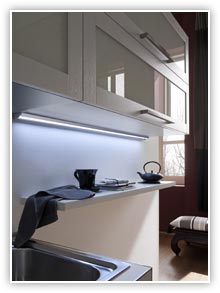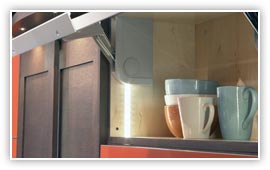By Daniel Tripp, Product Marketing Manager, Hafele
Photos Courtesy of Hafele
Many products on the market are labeled green, and it seems as if many companies are attempting to put a green spin on everything from reusable grocery bags to electric vehicles. In this product environment, how do you decide what is really green and what is green washing? In the end, each must make his or her own decision, and do what feels right. As you do this, I suggest applying the following approach. Take a closer look at the task at-hand, knowing that one option may offer more of a conservationist’s approach. And so it is when it comes to your choice of lighting.

In the last 15 years, there have been newer developments in halogen, xenon, fluorescent, and now LED lights to incorporate with furniture and cabinetry designs. While using incandescent bulbs seemed like a great idea and definitely the better choice when compared with using lanterns or candles, we now have more choices to compare them to, and the time is come that we give it our proper attention.
Just as we had to do when halogen or fluorescent became available, we now have to look at the available technology of LED and decide if it is the best choice for what we are trying to accomplish. The first thing we need to look at is how much light comes from the light source as compared to how much power it consumes. This is called the efficacy of the light. It is calculated as lumens per watt (lm/w). California passed a bill on October 12, 2007 that will require a light output of 25 lm/w by 2013 and 60 lm/w by 2018. The Federal government passed the Energy Independence and Security Act of 2007 that will require 40 lm/w by 2020. This is the same legislation that will ban the use of 100w incandescent bulbs after January 2012. Here is a look at the efficacy of the most common technologies available today:
| Incandescent | 12 – 18 lm/w |
| Halogen | 16 – 29 lm/w |
| Xenon | 10 – 30 lm/w |
| CFL | 60 – 70 lm/w |
| LED | 50 – 90 lm/w |
Based on the legislation that has already been passed, in a short few years, the only technologies that currently exist, which will be a legal option will be Fluorescent and LED. From the standpoint of power usage alone, it is actually a fairly close contest between Fluorescent and LED’s and if that was the only part of the deciding equation, they would both be very viable long term options. Unfortunately for the CFL, it contains a small amount of mercury – approximately 5mg. And while there are lots of discussions of whether they are the right choice vs. incandescent lights due to this fact, it does leave the door open for LED technology.

Using LED will not only be better for the environment, but it will save you money in the long run. The fixtures are admittedly more costly than the equivalent fixtures in incandescent or CFL, but over the life of the LED fixture you will actually save money due to savings on your electrical bill. For example at $1 each you would spend $1,386.00 for Incandescent fixtures in the example above, at $3 each you would spend $945.00 for CFL and at $25 each you would spend $1,575.00 for LED. So if you look at the fixtures alone the cost for LED is greater, but if you calculate the savings in power cost, the savings is apparent. Based on 63 fixtures and using them 4 hours a day and a cost of $0.11 per kilowatt hour the total cost of the 3 options are as follows for a period of 15 years:
| Light Type | Fixture Cost | Electrical Cost | Total Cost |
| Incandescent | $1,386.00 | $9,106.02 | $10,492.02 |
| CFL | $945.00 | $2,731.81 | $3,676.81 |
| LED | $1,575.00 | $1,214.14 | $2,789.14 |
Another thing to keep in mind is that in all commercial applications, someone has to be paid to change out the fixtures. So whether it is a light in a hotel room, a fixture in a jewelry store, or a light over a countertop – someone has to purchase the replacement bulb, and replace it, most likely in off peak hours. One other side effect of using incandescent bulbs especially is that they are only 10% efficient, so 90% of the power used is turned into heat. CFL’s and LED’s produce much less heat – but the heat produced by light fixtures has to be accounted for by the cooling system in a home or business. These are costs that are often overlooked when you are comparing the cost of one option over another. But it is very important to look at the total operating costs, not just the purchase price of the fixture.

Until now, most all of the lighting options for cabinetry was in the form of puck lights or a rigid (and not so pretty) fluorescent tube. Most all of the lights that have gone into kitchens have been on the bottom of the upper cabinets to shine down on the countertop with the occasional exception of some lights washing down onto the front of the cabinets. But have you ever stopped to notice that when you open your refrigerator, a light comes on, and when you open your microwave door a light comes on, and when something is in the oven, you can turn a light on. But when you open that base cabinet to find your missing pot or Tupperware lid, you have to do it in the dark.
Many designers are beginning to take advantage of the many new options that are available with LED. For instance, on the inside of cabinets you can now run strips of light to brighten things up. With puck lights, you would typically put a light on the inside top of a cabinet, but unless you had glass shelves, that light wasn’t going to do much good on the bottom of the cabinet. With the new LED strip lights, you can run a thin strip of light vertically up the side wall of the cabinet so that the entire cabinet is illuminated evenly. Another great place in the kitchen for strip lights is in the toe kick and on the top of the cabinets. This provides a great accent light or mood light that can be turned on when you are entertaining. You can also connect them to a motion detector, so that they come on automatically when you wander into the kitchen to get that drink of water in the middle of the night.
There are door and drawer sensor switches that you can also install to turn a light on only when you open your cabinet door or your cabinet drawer. You might think, “Why is a light in a drawer important?” On the practical side, it allows you to avoid turning on overall room lighting when you are locating something specific. I store batteries in a catch-all drawer in the kitchen and it seems like the TV remote only goes dead at night. So to be able to walk right up to that drawer and open it with a light that’s illuminating the particular space I’m searching is of great advantage.
Many of the light layers that can be added to a kitchen design are not absolutely necessary, but they will enhance the design.

Other impacting components to look at in lighting technology are dimmer switches, motion detectors, and whole house lighting control systems. When a light is dimmed 50% it is using 50% less power. This allows you to install great task lights over your countertop that are sufficient for you to work by and then dim them down while you eat so that they provide a pleasant mood light without using as much energy.
Motion detectors have been used on the outside of houses for many years, but now we can incorporate this technology into our homes. Kitchen, bath and closet spaces are ideal for implementing this small detail that is not only convenient but cost-effective, as the light is on, only as needed, and then goes off automatically.
California has already passed legislation known as “Title 24” that will require motion detectors for room lights in the future. One important consideration when you begin to use dimmers, etc. is to make sure that they are compatible with your lighting system that you have chosen. Many LED systems can only be dimmed on what is called the secondary side and cannot be controlled by a wall mounted dimmer switch. This is because many of the lights used in cabinetry are low voltage and use what is called a “driver” for a power supply. These modern drivers are electronic where the old transformers were magnetic. So even if you find an “electronic” dimmer switch, I would encourage you to try it out before you specify it, because they don’t all talk the same language and you might find that your lights only dim a couple of steps and then turn off. It is important to use technology that is compatible with each other.
One last consideration when choosing the lights for a design is safety. For most cabinet applications the light of choice has been halogen or xenon puck lights for the last several years. While they provide a very nice and bright light, they also get very hot. It is always important that you follow the manufactures guidelines when installing them to make sure that this does not pose an issue. A halogen lamp can reach the temperature of 280 F and a xenon lamp will run about 165 F. At these temperatures you will get burned if you touch the bulb.

So as you get ready to design your next kitchen or bath project, take a good look at the newest technology available as you strive to increase the aesthetics of your home.







